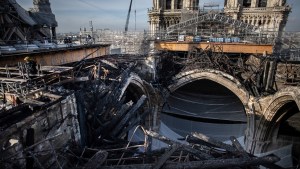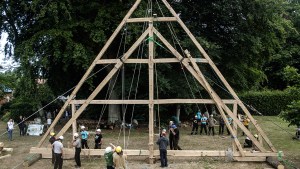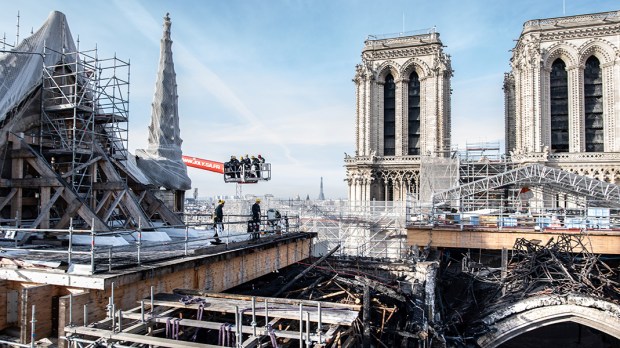A new episode of the PBS science program Nova takes a look at the challenges of rebuilding Notre Dame de Paris and the innovative approaches architects are taking to accomplish the task.
An intriguing combination of new technology with a knowledge of history, archaeology and ancient crafts provides hope that the cathedral, severely damaged in an April 15, 2019, fire, will be saved.
The hour-long program begins with a summation of the events of that day, dramatically recounting the fire that began in the cathedral’s attic. Firefighters put their lives at great risk to keep the fire from spreading to the bell towers, because if the timbers holding up the massive bells had failed, the falling weight could have led to a chain reaction resulting in the collapse of much of the cathedral itself.
Fortunately, that did not happen, but when the fire was extinguished and the smoke cleared, investigators began to see what a large challenge awaited rebuilding. The melting of 210 tons of lead on the cathedral’s roof left toxic dust practically everywhere, so restoration crews are forced to wear protective clothing and carefully remove it and wash equipment and themselves every time they finish a shift — slowing down their work.
Next, crews had to secure the walls of the cathedral, because if any of the interior arches collapsed, the force of the 28 flying buttresses pushing inward could bring those walls down. Craftsmen had to measure the interior “cutouts” of the buttresses — and not all of them are the same — to fashion timber supports to keep the weight on the outside.
Fifteen percent of the limestone vaulting had collapsed during the fire. It needs to be replaced, but if a limestone that is too heavy is used, the new vaults might not stay in place.
Microscopically examining the soft, porous limestone that had fallen to the cathedral floor, investigators found a rare fossil of plankton which gave them an idea where the stone might have been quarried some eight centuries earlier.Nova‘s cameras followed investigators into Paris’s catacombs some two miles south of the cathedral — former quarries that were filled with skulls and bones from some of Paris’ cemeteries that were closed in the 18th century. From the deepest seams of this quarry samples were brought back to the lab, where studies found matching planktonic fossils.
Though these quarries are no longer active, restorers now know what kind of stone to look for in quarries outside the city.
To rebuild the burned roof, the team catalogued all the timbers that had fallen the night of April 15, 2019, noting the position where they fell. Some were badly charred, but many still revealed identification markings that medieval carpenters had incised into them, helping the team to determine exactly where they were. Looking at the tree rings, they could also gain insights into what types of trees would be good for rebuilding.
The fire has prompted a wave of 3D digital scanning at historical monuments throughout France, to better document their architecture in case of similar catastrophes. In this technology, a laser bounces off each contour in a room, yielding millions of measurements in a data set called a “point cloud.”
At Notre Dame, this had already begun in 2006, and new data is being added to the point cloud to show “every stone, timber and iron nail in the structure, across time, from the 12th century to the present day,” the program says.
In 2014, architect Rémi Fromont spent an entire year mapping every inch of the timber in Notre Dame’s attic, which was also called the Forest. Combined with a 3D scan done of the attic in 2016, it will provide a map for rebuilding, with the exact geometrical measurements required.
Said Nova, “This extraordinary challenge will require around 1,300 oak trees, craftspeople versed in the lost art of medieval carpentry practices, and a blueprint for possibly the most geometrically complex timber structure in Europe.”

Read more:
Notre Dame choir to hold Christmas concert in empty cathedral

Read more:
These carpenters show off medieval techniques for building Notre Dame’s new roof

